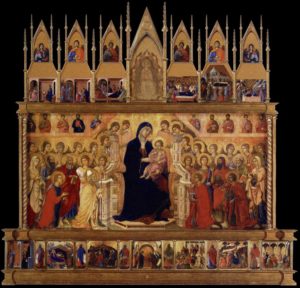1311
The dedication of a masterpiece
One of the reasons why the artistic explosion that we call the Italian Renaissance occurred first in the northern part of the peninsula was the flourishing of the city-state. Florence, Venice, Siena, Milan, Pisa, Mantua, etc., etc., all possessed wealthy urban elites with money to spend beautifying their churches, palaces and public places. In 1308 Siena commissioned the artist Duccio di Buoninsegno (c. 1255-1319) to produce a splendid new altarpiece for the cathedral of Santa Maria Assunta. Three years later Ducccio presented the masterwork known as Maestà (Madonna with Child Enthroned and Twenty Angels and Nineteen Saints). The massive work (16′ x 16′) features the Madonna enthroned in majesty (thus the Italian term “maestà”) and episodes from the life of the Virgin Mary and Christ. It was a landmark in Italian painting and part of the move from a static Byzantine presentation to more natural depictions.
An observer of the work’s dedication remarked:
And on that day when it was brought into the cathedral, all workshops remained closed, and the bishop commanded a great host of devoted priests and monks to file past in solemn procession. This was accompanied by all the high officers of the Commune and by all the people; all honorable citizens of Siena surrounded said panel with candles held in their hands, and women and children followed humbly behind. They accompanied the panel amidst the glorious pealing of bells after a solemn procession on the Pizza del Campo into the very cathedral; and all this out of reverence for the costly panel… The poor received many alms, and we prayed to the Holy Mother of God, our patron saint, that she might in her infinite mercy preserve this our city of Siena from every misfortune, traitor or enemy.
